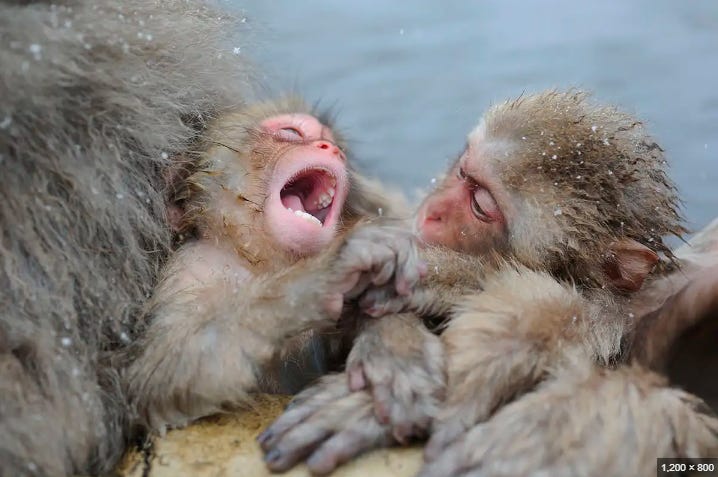What do catching a cold and yawning have in common?
Synchronization of downtime in families with young children
Yawning is contagious. Just reading this sentence might make you yawn. Why is that? I suspect that yawning may have evolved as a way to promote synchronization of restfulness among the members of a nuclear or communal family with young children.
Falling asleep is crucial and at times difficult for young children. Often, they need close contact and attention (breastfeeding, singing lullabies, rocking, etc.) from parents, caregivers, or possibly older siblings. From an evolutionary point of view, one might imagine a group of social mammals or primates inhabiting a small den-like environment, where all members of the family are present in close quarters. In such an environment, moving around and being restless or active is not helpful for promoting a resting state for the young that have a developmental need for sleep. Yawning could be the young child’s signal that it is time for the household (or “denhold”) to quiet down. The signal is contagious, inducing a move toward the resting state for other members of the family — especially the mother or close caregiver who is most attuned to the baby or toddler’s state — as they too begin to yawn and wind down.
Researchers have postulated that the contagiousness of yawning, which has only been documented in social animals, may have evolved as a mechanism promoting synchronization of a social group with respect to group movement or group transition to sleep, or to promote increased vigilance in the group. However, a possible role of contagious yawning in synchronizing the transition to sleep or restfulness specifically with respect to families with young children (household or “denhold”) does not seem to have been mentioned or focused on in the scientific literature.
I have a suspicion that a similar phenomenon may be at play when parents “catch” colds from their toddlers (that is, when parents get sick with a cold in quick succession to their young children). Such apparent contagion is often reported by parents, especially when their children first start attending group daycares.
Toddlers need close attention and love from their parents, all the more so when they are sick. Each illness is an intense experience. The child, normally bounding with energy, like a supercharged Energizer bunny, looks and acts like they’ve had about 99 of their 100 or so batteries suddenly removed. Presumably, the developing gut, skin and respiratory microbiomes and immune system are working overtime to adapt to the latest pathogenic or environmental challenge introduced into their little growing body.
When the toddler is sick, it’s obviously not an ideal time for Mom and Dad to be staying late at work, focusing on important meetings or presentations, or having high stress events or deadlines. Downtime is needed, for everyone in the household (or “denhold” from a more evolutionary point of view), so that the child gets the close contact and attention they need to work through the growth process of managing the illness.
Denis Rancourt, in his conversations with me and possibly in his essays or book, has suggested an interesting concept about one possible role of cold and flu-like illnesses in animals. In my understanding of this concept, there is a natural and semi-rhythmic function of getting sick with a cold or flu-like illness. Having a cold can be a way for your body to tell you to take a break, slow down, and put aside the punctual activities of life that require activation of the body’s stress-response system. The onset of the cold might occur at a time when one is ready to take a pause, such as after an important deadline at work, or it might happen at a seemingly adverse time, like once you’ve finally arrived, after long travel, at a vacation destination where you intend to relax, without the usual daily responsibilities you would have at home. Either way, when the level of perceived stress to perform in response to external demands is suitably low, the cold or flu-like illness walks in and forces or invites the individual to take a break, perhaps so that some needed internal physiological or psychological maintenance work can be done.
Such a natural function of cold and flu-like illnesses could act in a way to synchronize the members of a nuclear family. Perhaps we have evolved in such a way that when our young children become sick with cold or flu-like illnesses, we are also predisposed to getting sick, which would benefit the family group in that all members, including the parents or caregivers, must drop the external demands and stresses of life outside of the home and enter a mode of downtime while the young child or children recuperate and develop their internal systems, microbiomes included, with the undistracted attention of their adult caregivers.
If the contagiousness of yawning evolved as an advantage with respect to the transition to restfulness in a nuclear family, regarding crucial developmental sleep in young children, then this could mean that the rest of society is afflicted by the same contagiousness as a simple (boring?) by-product, like goosebumps in furless and featherless humans. Adults are stuck with yawning when others yawn, regardless of whether there are young children around, and the adults discern no particular benefit from it. Maybe the same is true about contagiousness of the common cold: an evolutionary benefit for families with young children, and an annoyance or worse for everyone else.




